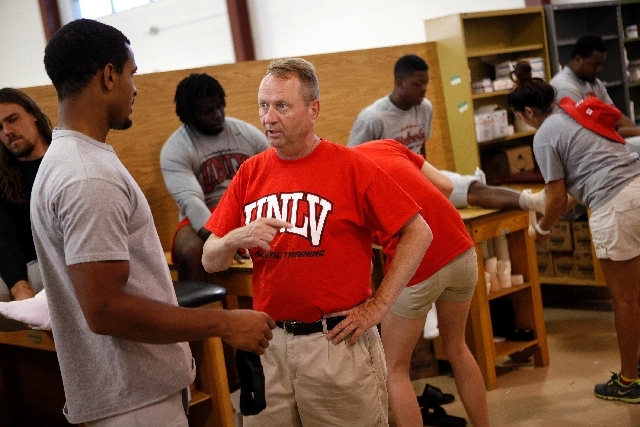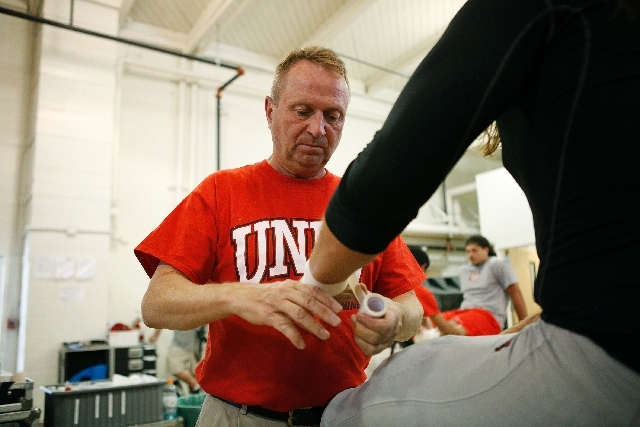Coaches, staff learn to take players’ risk of concussions seriously


ELY — Tim Hauck was playing in 1997 for the Seattle Seahawks when he was blindsided during a punt return by a Denver Bronco.
Shortly into the second half, he asked a fellow safety what had been happening in the game.
But even if Hauck’s short-term memory was gone, no way he was going to the bench.
“Back then, as long as you could play, you could play,” Hauck said.
It’s a mentality that was prevalent not only in the NFL, but in all levels of football. A little ding to the head was no reason to miss more than a play or two.
Hauck suffered 10 possible concussions during his 13-year NFL playing career, but never missed a game because of any of them.
Now as UNLV’s first-year defensive coordinator, Hauck operates under a completely different mindset. He — as well as brother Bobby, the head coach, and the rest of the staff — must be on the lookout for a player who suffers any kind of potential head injury.
Staffs throughout the country, from Pop Warner to the NFL, must have a heightened awareness of concussions.
“I think in terms of head injury, our players are far safer than they’ve ever been in the history of the game,” Bobby Hauck said. “I’ve coached on a lot of staffs with a lot of guys. It’s being taught safely, at least everywhere I’ve been. The equipment’s better than it’s ever been.”
The coach wouldn’t allow players to be interviewed for this story, saying he didn’t want players targeted by opponents during the season.
UNLV uses up to five sets of tests to determine if a player has a concussion and, if so, the seriousness of the injury.
The first test is a question-and-answer to determine the extent of how he’s feeling. From there, it moves on other types of exams, such as balance, and the results are compared to tests given before training camp begins because each athlete’s results are different.
Each type of head injury is different, too, and can affect players in vastly varied ways.
“As the research improves, they’re going to have more tests (so) that it’s going to be harder for student-athletes to hide the fact they have a head injury,” UNLV head athletic trainer Kyle Wilson said.
The training staff isn’t alone in determining who has a head injury. Coaches and even teammates sometimes approach a trainer to say a player is having trouble remembering plays or acting oddly.
“We’re not trying to rat on them or get them in trouble,” Wilson said. “Everybody wants to play and compete, but we need to make sure we’re doing that in a safe manner. We had multiple cases last year where teammates came forward.”
A general sense of cooperation exists because of the awareness of long-term negative effects concussions can have. Some retired NFL players say they suffer from dementia and other neurological problems.
The NFL and a group of about 4,200 ex-players have been ordered by a federal judge to try to settle their dispute in mediation. If a lawsuit goes to court, it could be worth billions of dollars.
The NCAA, no doubt taking notice, created a rule this season that players will be ejected for “targeting” an opponent, meaning intentionally going after the head.
“It’s not real clear about what’s targeting and what isn’t targeting, what they’re going to call and what they’re not going to call,” Tim Hauck said. “They say, ‘Well, they do it in the NFL.’ No, it’s not the same. In the NFL, you don’t get ejected.
“It’s a huge penalty.”
Wilson, in his 30th year at UNLV, has seen considerable change when it comes to attitudes toward concussions. Not many years ago, such injuries were thought of as more annoyance than serious.
“We just didn’t know as much back then as we do now,” Wilson said. “Right now, we’re much more cautious with people we suspect have a head injury. It’s definitely changed for the better.”
Wilson said UNLV’s current coaches stay on top of possible head injuries, even if removing such a player might hurt their chances of winning a game.
If a player is diagnosed with a concussion, he is held out of practice completely until he passes the tests, which could take anywhere from an hour to a month.
Once a player passes, he begins at least a seven-day process of slowly getting back into full physical activity.
Bobby Hauck is careful to say he “has complete confidence in our medical people,” but wonders whether the nationwide trend of dealing with concussions by instituting harsh game rules is too reactionary.
“I think that we have to be wary of going overboard,” he said. “Sports are physical. Whether it’s riding a bike or riding in a car, there’s risk to it. We’re going to take care of our guys and make sure they’re in good shape before we put them back out there. I think Kyle Wilson’s got a pretty good handle on it.”
Contact reporter Mark Anderson at manderson@reviewjournal.com or 702-387-2914. Follow him on Twitter: @markanderson65.












